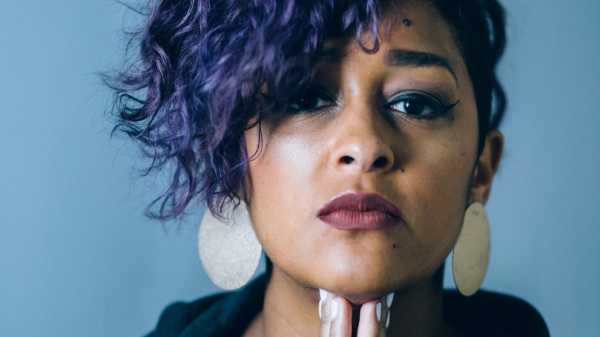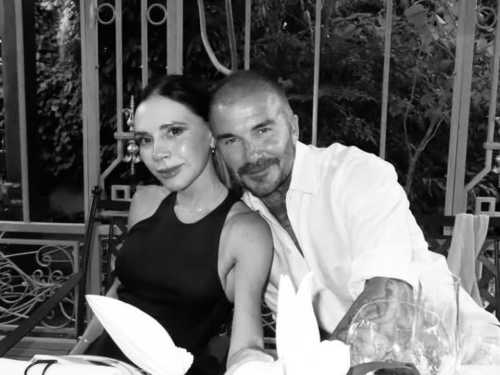
In an interview with the rapper Kanye West from 2003, shortly before he
released “The College Dropout,” West recounted the time he met the poet
Gwendolyn Brooks, at a dinner held for students in Beverly Hills,
Chicago, when he was in “fourth grade or sixth grade.” Brooks asked him
if he had a poem to read, West recalled. “I said”—here, the interviewer
writes, he put on a high-pitched boy’s voice—“ ‘No, but I can write one
real quick.’ I went in the back, wrote a poem, and then read it for her
and the 40 staff members.”
I thought of West’s anecdote last November, when I visited Chicago to
see “No Blue Memories: The Life of Gwendolyn Brooks,” a shadow-box play
written by the Chicago poets Eve L. Ewing and Nate Marshall and staged
by the local theatre troupe Manual Cinema at the Cindy Pritzker
Auditorium in the Harold Washington Library Center. In the national
arena, Brooks—who was appointed the Poet Laureate of Illinois in 1968,
and of the country in 1985, and who died in 2000, at the age of
eighty-three—is regarded as a charmingly accessible stylist, a “race
hero” who reported nobly from the trenches of the black poor. But in
Chicago it is her social work—particularly as an educator and an
advocate for schoolchildren—that is treasured and understood as a
critical part of her artistic legacy. To Brooks, poetry was citizenship.
In Chicago, her radicalism is at center stage.
“So many of the spaces that rappers in Chicago use to hone their skills
and build their name are the same spaces where poets are doing the same,
and so we’re in the same community—and oft times the same people,”
Marshall told me recently. “I think a lot of the rappers are influenced
by Brooks in their commitment to rendering their own communities with
love and complexity.” The very idea of a city arts scene can seem
antiquated—rendered unnecessary by the hyper-connectivity of the
Internet. But Chicago, a city that was home to a literary renaissance in
the early twentieth century, and to the nation’s first black-art gallery
(the South Side Community Art Center), and was the birthplace of
Poetry magazine, continues to produce cultural works of social
realism. Ewing and Marshall are among dozens of celebrated
artists—including Chance the Rapper, Mick Jenkins, Noname, Saba, and
Jamila Woods—who attended the open-mic nights organized by Young Chicago
Authors (an arts-education hub that “exposes young people to hip-hop
realist portraiture,” according to its literature) when they were in
school, and who went on to make art that is intensely local, rooted in
the radical black vernacular. You can hear Brooksian turns of phrase in
Chance’s “Sunday Candy,” or in “Holy,” from Woods’s 2016 album, “HEAVN,”
(“The lover may leave / The winter may not”).
“There is a Midwestern cultural aspect to it—a cultural norm of sharing
and abundance, rather than scarcity and competition,” Ewing told me,
shortly before the last production of “No Blue Memories.” (Ewing
recently told me that the play will be staged again in Chicago later
this year.) We met in the library, under Jacob Lawrence’s
mosaic “Events in the Life of Harold Washington,” which depicts the life
of Chicago’s first black mayor. Ewing, striking and assertive, her hair
dyed the multiple colors of dawn, took off her coat to reveal a marigold
jersey that read, “We all we got.”
“When Langston Hughes came to Chicago, it was to work collaboratively,
to work in a theatre company, not to hole up and write the Great
American whatever,” Marshall, who is soft-spoken, tall, and bearded,
said. He was wearing a shirt that read, “Nothing is the new black.”
Ewing’s younger brother was a childhood friend of Marshall’s, and the
two poets talk in the anticipatory rhythm of siblings. They wrote “No
Blue Memories” together after forming a partnership that they named
Crescendo Literary, after a line in Brooks’s poem “To the Diaspora.”
In Chicago, the boundaries between activism and art have a way of
dissolving. Brooks, who lived in Bronzeville for most of her life, was
an architect of that borderlessness. In “No Blue Memories,” Brooks,
played by N. LaQuis Harkins, reads some of the letters she wrote to her
admirers of all ages, including a character based on Etheridge Knight, a
Black Arts Movement poet who wrote “Poems from Prison.” With “Annie
Allen,’’ a poetry collection published in 1949, when she was just
thirty-two, Brooks became the first black person to win the Pulitzer
Prize. Brooks was aware that her involvement in New Black Poetry and
that her more radical poems, which explode the conventions of verse,
remain much less well known than her earlier work. “Sometimes I fear
these anthologies prefer me presented as a minor detailist, principally
interested in beans and daisies and summer eves,” she wrote to an editor
at Norton, in 1992, referring to the title poem of her collection, “The
Bean Eaters,” from 1960.
As an undergraduate, studying literature at the University of Chicago,
Ewing wrote her thesis on Brooks’s consciousness shift. “I feel that the
spirit of Miss Gwendolyn Brooks visited me when I was nineteen, in my
dorm room, and compelled me to pursue a literary life,” she explained,
aware that she might sound credulous. We were sitting in the holding
room adjacent to the Pritzker Auditorium. “I took this
black-women-writers course, and it was the first time I read her
complete anthology ‘Blacks,’ and I realized what a slim and
non-representative image of her work I had been given,” she continued.
Ewing went on to the Harvard Graduate School of Education, where she
received a doctorate in sociology. She is developing her thesis,
“Shuttered Schools in the Black Metropolis: Race, History, and Discourse
on Chicago’s South Side,” into a book. Her experiences teaching—in the
Chicago public-school system, and now at Stateville maximum-security
prison—make their way into her short fiction and poetry, much of which
explores the interior urges of her giddy, curious, black-girl speakers.
“I mean I’m here / to eat up all the ocean you thought was yours,” the
poet writes, in “what I mean when I say I’m sharpening my oyster knife,”
a poem from her energetic new collection, “Electric Arches,” which also
draws from Zora Neale Hurston.
It was important to Marshall and Ewing, who tested the play on an
audience at Gwendolyn Brooks College Preparatory Academy, on the South
Side, that Brooks’s political awakening formed the arc of their
narrative. In one scene, we watch a middle-aged Brooks enter the second
Black Writers’ Conference, at Fisk University, in 1967, where she was
moved by the revolutionary principles of a playwright
named LeRoi Jones, who would later rename himself Amiri Baraka.
“No Blue Memories” was just one of the many tributes devoted to Brooks
on the year of her centennial—others included a monumental mural,
painted by the artist Kerry James Marshall, on the façade of the city’s
Cultural Center, and a book, “The Golden Shovel Anthology,” featuring
more than a hundred contributors, such as Nikki Giovanni and Tracy K.
Smith. (A “golden shovel,” a form that the poet Terrance Hayes created
in honor of Brooks, is a kind of poem in which the final words of each
line come from another, source poem; it is also the name of the Chicago
pool hall where Brooks observed the truant young men she would write
about in “We Real Cool,” a poem that sounds like jazz: “We / Sing sin.
We / Thin gin. We / Jazz June. We / Die soon.”)
“There’s a question of What Would Miss Brooks Do?” Marshall told me,
when I asked him about Brooks’s influence on his work. He is a professor
at Northwestern University, the director of the Young Chicago Authors’
National Programs, a rapper, and an acclaimed poet of “bewildering
fluency,” as Roger Ebert put it. As an eighth-grader, he won the Young
Poetry Award that Brooks established, judged, and, for a time, helped
fund. Like Brooks, Marshall named his first book, “Wild Hundreds,” after
a Chicago neighborhood, and the fluttering, associative spirals of
language in poems such as “hoodwood” drop you right in the psyche of a
child, learning about the dangers and the wonders of his surroundings:
“We heard our mothers best / white voices rattle alarm into our
telephones. / every kid & old folk perched on porches.”
On a tour of the Harold Washington, where the organization YouMedia puts
on spoken-word showcases for student poets, we stopped by a bust that
was supposed to be of Brooks but, with its crude rendering of her Afro,
didn’t much resemble her. “Way ugly,” Marshall said. Ewing playfully
swatted the air around him. Ewing showed me the tiny renderings of
buildings, typewriters, and what looked like a kitchen, all drawn on
acetate, that the actors at Manual Cinema would make come alive with a
projector. “Five hundred puppets in an envelope,” she said. Jamila Woods
(who is also an associate director of the Y.C.A.), and her sister
Ayanna—both friends of Ewing’s and Marshall’s, who have known each other
for years—were in charge of the music: their compositions were inspired
by Brooks’s stanzas.
As the auditorium filled, Ewing and Marshall, receiving the hushed
attention of local celebrities, went to sit with their families. For the
beginning of the play, Brooks was captured in a perpetual bookish fugue,
hunched over a notebook or typewriter. The audience—some of whom had
waited in the cold for tickets to the free event—laughed at the young
poet’s obliviousness to her surroundings as she bumped into her mother
and father (also silhouettes) in their small Bronzeville apartment. “She
was like that,” I heard a silver-haired man say, authoritatively, as we
filed out of the theatre.
Sourse: newyorker.com






